
Shaw creeping vigna - a subtropical legume
Author: Bede Clarke
Introduction
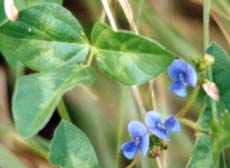
Shaw creeping vigna (Vigna parkeri) is a prostrate or climbing herbaceous perennial legume. It grows many stolons, which readily take root at the nodes. It is nutritious, with digestibility levels closer to temperate than tropical legumes.
Shaw is native to the more elevated and better-watered grassland areas of equatorial East Africa. Under moderate grazing pressure it forms dense mats with slender stolons 1–2 m long. It grows in sward-forming grasses, and climbs tall tussock grasses.
It is suited to warm hill sites, in common with other twining tropical legumes, but has a unique persistence under heavy grazing and competition from dense stoloniferous grass.
Introduction into Australia
Creeping vigna was introduced into Australia from Kenya and Uganda in the 1950s and evaluated by the CSIRO at the Beerwah Research Station in south-eastern Queensland.
It was not considered particularly useful, as yield was the prime selection factor. The introductions from Uganda became naturalised over 20 years, spreading across the grounds of the research station, growing successfully in combination with pangola, bahia and setaria grasses. From these introductions the Shaw cultivar was selected and jointly released by the CSIRO (Tropical Crops and Pastures) and the Queensland Department of Primary Industries.
Shaw also persisted at other (abandoned) evaluation plots in the region, and has spread, helped by grazing stock excreting its seed.
It was registered in 1985. In New South Wales, Shaw has the potential to colonise the subtropical coastal areas.
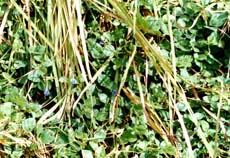
The picture (right) shows how Shaw has more leaf and less stem than other tropical legumes, making it easier for stock to digest.
Adaption
On the far north coast, Shaw is adapted to warm moist sites on hillsides, and moist but well-drained lowlands with a warm coastal climate. Shaw does not perform well in waterlogged paddocks. The other extreme, drought, kills it. Frost kills the leaves and stems but the sward regrows after frosting. Sow Shaw in largely frost-free sites with a minimum average annual rainfall of 1100 mm.
Shaw grows best on fertile soils, but tolerates low fertility and low pH; in southeast Queensland, Shaw is naturalised in soils with analyses as low as pH 5 and 13 mg per kg of bicarbonate extractable phosphorus (Colwell test).
Shaw shows some shade tolerance in the warm, lightly timbered hill country of the Tweed and Upper Richmond Valleys.
Establishing shaw pastures
Seed treatment
Shaw has up to 96 per cent hard seed content, unchanged after three years of laboratory storage.
The seed has a good germination rate (up to 80 per cent) after scarification with acid or mechanical abrasion.
On the far north coast, an amount of hard seed (approximately 30 per cent) is essential for sowing during the dry spring. To check for hard seeds, place about 100 seeds on moist cotton wool and, 24 hours later, count the percentage that have not swollen. The best temperature for germination is 25°C.
Inoculation
Inoculation with Group I inoculum (cowpea) is recommended, although in southern Queensland Shaw successfully nodulates with naturalised strains of rhizobium. Lime pelleting is only necessary if mixing with superphosphate; the lime coat protects the rhizobium from the free acid.
Sowing
Shaw is best sown in early spring and mid-summer, but may be sown anytime from September to March. However, in frost-prone areas do not sow later than February, as frost kills young plants.
Shaw is slow to establish and form a vigorous network of stolons. It produces little or no seed in the first year.
Sow at a shallow depth into a well-prepared seedbed and follow with a heavy roller. Also suitable is direct drilling into existing pasture, and aerial seeding into herbicide-treated pasture or rough seedbeds; Shaw was successfully established in Kyogle (Upper Richmond Valley) by helicopter seeding in October, following a burn.
The usual seeding rate is 2 kg per ha. But a low seeding rate (0.5 – 1 kg/ha) is sufficient, given the high price of the seed, the plant's excellent colonising ability, and the usual practice of sowing two legumes. There are 75,000 seeds per kg.
Fertiliser
Compared with white clover, Shaw is a highly phosphorus-efficient legume. It also has a moderate molybdenum requirement.
On soils with low levels of available phosphorus, sow with 250–350 kg superphosphate per ha. For soils with low-to-medium phosphorus buffering capacity (PBC), aim to raise the phosphorus level (measured by the Colwell method) during the pasture development phase to 20 mg/kg, then maintain with annual rates of 100–125 kg/ha superphosphate.
For the high PBC red basalts and heavy clay alluvial soils, a critical Colwell phosphorus level of 35 mg/kg is suggested, until further research data is available. A critical soil test figure is that which yields near-maximum dry matter.
At establishment, apply 50 g/ha molybdenum if the CaCl2 pH is below 5.5. High PBC soils may require 100 g/ha molybdenum, depending on recent fertiliser history. High PBC soils require maintenance molybdenum at 50 g/ha every three years; low-to-medium PBC soils require the same amount, but only every five years. At sowing, molybdenum is best applied as molybdenum trioxide (60 per cent molybdenum) with the seed pellet, or as molybdenum superphosphate (0.02 per cent molybdenum, 9 per cent phosphorus).
Soils derived from sandstone, shale and granite usually have low PBC. Medium PBC soils include chocolate basalts and medium-textured alluvials. High PBC soils include red basalts and heavy clay alluvials.
Companion species
Grasses
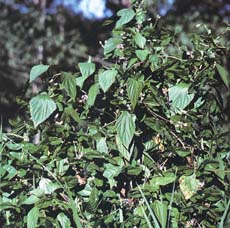
Shaw is best grown with sward-forming grasses, such as carpet grass, kikuyu, pangola, paspalum, broadleaf paspalum and Competitor bahia. It can be grown with setaria and Rhodes grass, but these must be managed so that light can reach the legume stolons.
Shaw's growing points and dormant buds are protected from heavy grazing when they are grown with sward-forming grasses. But they are more easily eaten when climbing the tillers of tall tussock grasses.
You can help to control broadleaf weeds such as crofton with a summer-growing combination of Shaw and a pasture grass (as pictured, right), but keep out stock during the summer growing season.
Legumes
White clover, Kenya clover and Maku lotus are suitable companion legumes. Kenya clover is particularly good in drier improved pastures, as it continues to grow during dry spells, when Shaw dies out.
Management
On the far north coast, Shaw grows best from January to May. It starts flowering in late March, somewhat later than in Queensland. In the establishment year, light grazing is recommended. Once established, Shaw tolerates prolonged heavy grazing. Allow Shaw to seed in the first or second year, so there are future seed reserves in the soil if the existing plants are killed by drought.
Grazing pressure should be set to produce a low leafy canopy. Bulky, undergrazed stands develop severe leaf diseases.
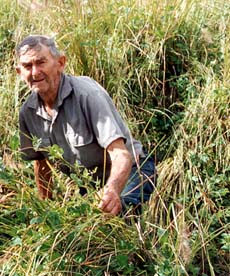
[The picture on the right shows grazier Bill Tindall with Shaw creeping vigna climbing through swamp foxtail (Pennisetum alopecuroides) at Kyogle, NSW.]
Animal production
No grazing trials have been conducted on animal performance with Shaw-based pastures on the far north coast. However, farmers with commercial Shaw-based pastures report improved livestock performance; Shaw contributes to pasture digestibility and protein levels in late summer and autumn, when dry matter digestibility commonly drops below 60 per cent and protein levels fall to 7 per cent crude protein — the critical crude protein level for maintaining acceptable livestock intake levels for tropical pastures.
The CSIRO has measured uncorrected in vivo dry matter digestibility at 65 per cent (leaf) and 55 per cent (stem). Leaf digestibility does not change greatly throughout the season.
In twenty years of grazing in Queensland, no animal health or anti-nutritional problems have been linked with Shaw pastures.
Seed production
The far north coast is not ideally suited to commercial seed production because of late flowering, wet autumns and leaf diseases.
Weed control
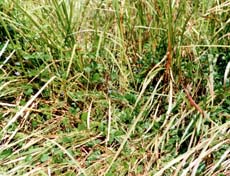
Shaw is sensitive to most herbicides so weed control is limited to mechanical, rope-wick, chipping or manual measures. Stock grazing on Shaw also offer a degree of weed control, as Shaw grows over low broadleaf weeds which may then be trampled by stock. The picture on the right shows blady grass (Imperata cylindrica) flattened by stock feeding off the Shaw (also pictured).
Table 1. Growth of Vigna parkeri pure swards (non-irrigated) cut at 6-week intervals, Redland Bay Qld.
| Month cut | Yield (DM) | ||
|---|---|---|---|
| Daily (kg/ha) | total (t/ha) | total (%) | |
| September | 0 | 0 | 0 |
| October | 0 | 0 | 0 |
| November | 53.5 | 2.25 | 26 |
| January | 47.5 | 2 | 24 |
| February | 55.5 | 2.5 | 29 |
| April | 21 | 0.8 | 9 |
| May | 11.5 | 0.5 | 6 |
| June | 11.5 | 0.5 | 6 |
| Source: Dr Max Shelton, University of Queensland, unpublished data | |||
The graph below shows approximate growth rates of Shaw Creeping Vigna growing with kikuyu under acceptable grazing pressure on the far north coast of NSW
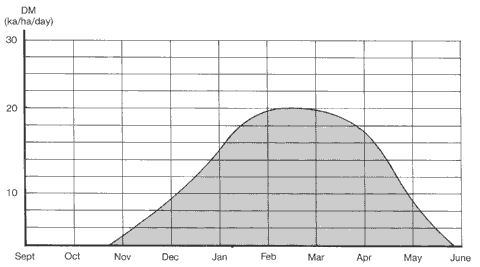
Pests and disease
Late season Shaw pastures on the far north coast are affected by Stemphylium and Cercospora leaf spot. Prevent fungal disease build-up with grazing management of the sward to allow good air circulation and light penetration.
No major insect pest problems have been encountered.
Root-knot nematode (Meloidogyne javanica) infects Shaw but is not a widespread problem.
Photographs by Bede Clarke

